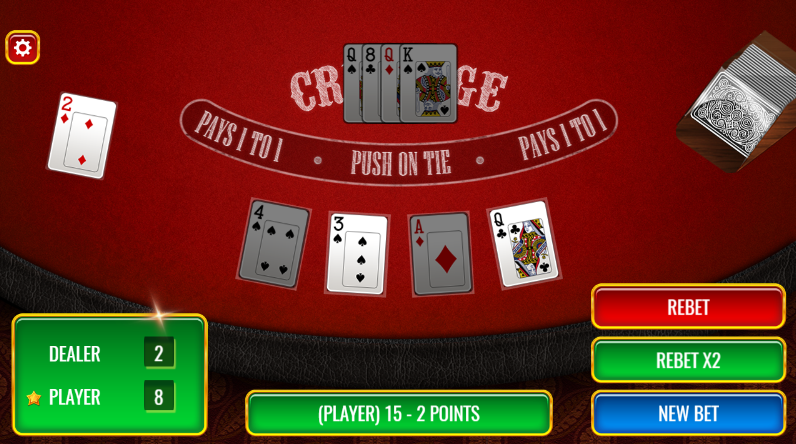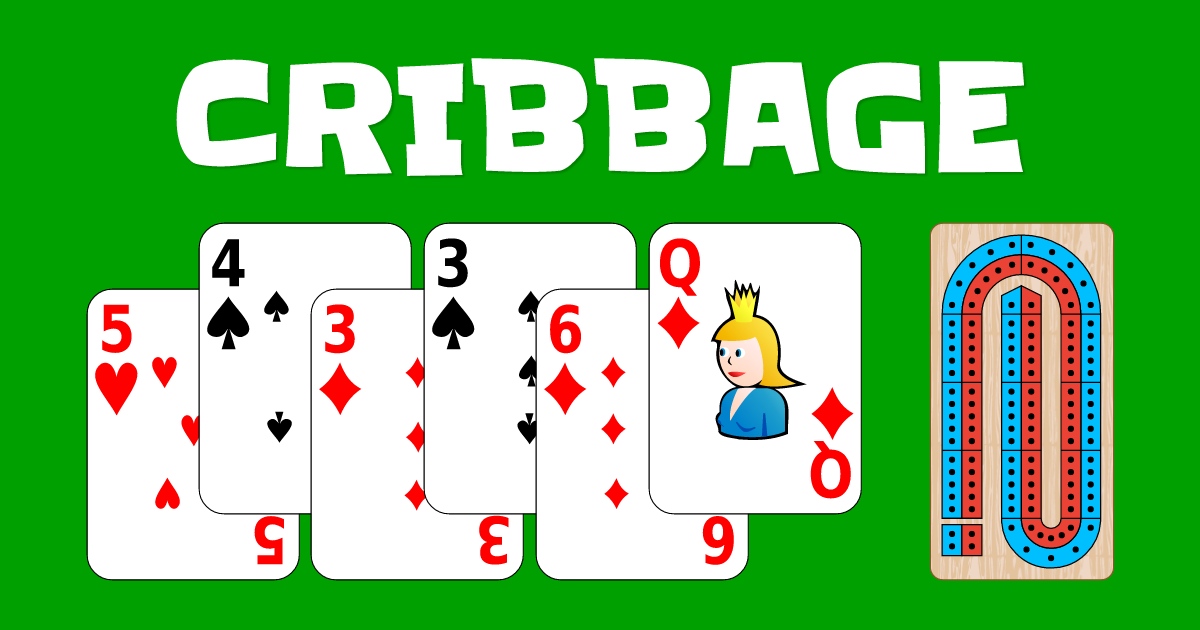
Cribbage Rules
Objective
The objective in Cribbage is to be the first player to get 121 points. The gameplay is divided into three distinct parts, The Deal, The Play and The Show. Each part is explained in detail below.
This version of Cribbage is for two players, there are many other variations possible, but these rules are only for the variation we've chosen for this site. There are a lot of rules, I've tried to explain them as best I can here, but you can also look at the rules at www.pagat.com or at Cribbage Corner, both of those are good places to learn how Cribbage works.
The Deal
The game starts with both players drawing a card from the deck to find out who is the dealer. The person that gets the lower card is the dealer. If the players draw equal cards then they draw again until the dealer can be determined. This way of determining the dealer is only done in the first round, in subsequent rounds who is the dealer will alternate between the two players.
In the above example, note that the J toss is statistically correct even though it means risking a crib flush. Your chance of giving up this rarest of cribbage scores is about 1 in 140 when you toss two cards of the same suit. This represents an added risk of approximately.036 points. Can you score a flush in cribbage SIDS is 4 or more cards in the same suit (for example, four diamonds). If you hold 4 cards of the same suit in your hand, you score 4. If the degeneration card is also the same suit, you score 5. However, in the crib, only a 5-card blush will be considered (the 4 cards in the crib and the degeneration card.
The dealer deals 6 cards to himself and 6 cards to the opponent. Each player then chooses two cards from their hand to put face down into the crib. The crib belongs to the dealer and is used at the end of the round to gain extra points. Which cards you choose to put in the crib is very important, as it affects how many points you can get in later parts of the game.
At this point each player has four cards in their hand, and the Crib has four cards. The deck of cards is then put to the side, and the non-dealer (also called a pone) cuts the deck and then reveals the top card. This card is referred to as the starter or the cut. If the starter is a Jack then the dealer immediately scores 2 points. This is known as Two for his heels. Once the starter card has been shown, the players are ready to proceed to the next part of the game.

The Play
The pone (the player who is not the dealer) starts by laying down a card on the table and announcing its value, e.g. lays down a 6 and announces 'Six'. The dealer then lays down a card and announces the cumulative value of the cards on the table, e.g. he lays down a 5 and announces 'Eleven'. This continues with the players laying down one card each until a player cannot lay down another card without the cumulative value going over 31. The player then says 'Go' and the other player can then continue to lay down his cards until he also can't lay down a card without going over 31. He then says 'Go' as well, and the player who laid down the last card will score 1 point if the total value is under 31 but 2 points if the value on the table is exactly 31. They then reset the count to 0 and continue with their remaining cards, starting with the player who did not lay down the last card. An ace is counted as 1, face cards are counted as 10 and other cards are their normal value.
During this phase there are several ways to score points, based on how you lay down your cards. Points are scored as you lay down your cards, e.g. if your opponent has just laid down a 4 and then you lay down another 4 on top of it then you will score a pair. The starter/cut card is not used at all in this part of the game.
Players always announce the cumulative value of the cards on the table when they lay down a new card. If they score points they will announce the points as well, e.g. 15 for 2, or 31 for 2. When a player has said 'Go' then the other player will say '1 for the Go' when he's claiming the point from laying down the last card. He might also say '1 for last', if the other player has not laid down any cards since the value was last reset. 1 for the Go or 1 for last are just different ways of announcing the same thing, that the player gets 1 point because he laid down the last card under 31.
Scoring during The Play
- Fifteen: For adding a card that makes the total 15, score 2 points.
- Pair: For adding a card of the same rank as the card just played, score 2 points.
- Pair Royal (Three of a kind): For adding a card of the same rank as the last two cards, score 6.
- Double Pair Royal (Four of a kind): For adding a card of the same rank as the last 3 cards, score 12.
- Run (sequence) of three or more cards: Score 1 point for each card in the sequence. The cards do not need to be in order, but they do need to be all together. E.g. H2 C8 D6 H7 S5 is a 4 card sequence because C8 D6 H7 S5 can be re-arranged into S5 D6 H7 C8, but H2 C5 C7 D7 S6 is not a sequence because the extra 7 in the middle breaks up the sequence of 5-6-7. Basically if you can take n cards that are in order and re-arrange them so all the n cards form a numerical sequence then it's a sequence.
- Last card, total value less than 31: Score 1 point.
- Last card, total value exactly 31: Score 2 points.
Cribbage Flush In The Crib Set
It's worth noting that even though all face cards count as 10, you cannot create a pair, pair royal or double pair royal with cards unless they have the same 'real' rank. E.g. two queens are a pair, a queen and a king aren't, even though they are both valued at 10. For sequences an ace is always low, you can't make a sequence with a king and an ace next to each other.
It's also worth noting that you can make points in many ways with the same cards. E.g. if the cards on the table are DA C7 and you lay down H7 you will get 2 points because 1+7+7=15 and 2 points because 7+7 is a pair of sevens. So, in that case you would announce 'Fifteen for 4'.
This part of the game continues until both players have played all their cards. The scores are updated as soon as a player gets points, and if a player reaches the target score, 121, the game is finished immediately.
The Show
Once The Play is finished, the players take back their cards from the table and it's time to calculate the score for their hands, and the crib. These are always scored in the same order: pone's hand, dealer's hand, dealer's crib. As before, the scores are added to the scoreboard as soon as they are calculated, and if a player reaches 121 the game is over immediately, the other player doesn't get to count his score. This means that there's no chance of a tie, or both players going over 121 in the same round. The dealer will normally get more points since he scores both his hand and the crib, but the pone scores his hand first, so if they're both close to 121 the pone might win, even though the dealer would have gotten more points if he were allowed to count them.
The Show Scoring
The scoring for The Show is similar to the scoring for The Play, but with some important differences. The starter card is used here with both hands and the crib, so a hand is the hand + the starter, and the crib is the crib + the starter. You can use the same card for many different combinations, e.g. it can be part of a pair and also part of a sequence.
Cribbage Flush In The Crib Combo
- One for his nob: For having the jack of the same suit as the starter, score 1 point. E.g. starter is H4, you have HJ.
- Fifteen: Any combination of cards that sum to 15. You can re-use cards, so if you have HJ, SJ and C5 you get 2 points for HJ C5 and another 2 points for SJ C5.
- Pair: For any pair of cards, e.g. SQ DQ, score 2 points.
- Pair Royal (Three of a kind): For any three cards of the same rank, e.g. S8 C8 H8, score 6 points.
- Double Pair Royal (Four of a kind): For any four cards of the same rank, e.g. HA SA DA CA, score 12 points.
- Run (sequence) of three or more cards: Score 1 point for each card in the sequence. E.g. for SA H2 C3 D4, score 4 points.
- Flush, 4 cards: If all the cards in your hand are of the same suit, e.g. SA S5 S9 SJ, score 4 points. These four cards all have to be in your hand, you cannot have three cards in your hand + the starter count as a flush. A 4 card flush also can't be used for the crib, only for your hand.
- Flush, 5 cards: If all the cards in your hand, and the starter card, are of the same suit, e.g. SA S5 S9 SJ SQ, score 5 points. You can also get a 5 card flush for your crib, if all the cards in the crib and the starter are of the same suit.


Skunks and Double Skunks
A skunk is when a player wins by over 30 points, his opponent has less than 91 points when the game is over. A double skunk is when a player wins by over 60 points, the opponent has less than 61 points. Normally a skunk will count as two games and a double skunk as 3. However, on this site we're not playing multiple games, we only track each game individually. We will however show you an image of a skunk or two if you get a skunk, and we do keep track of skunk counts for the statistics page.
Cribbage Flush In The Crib Queen
Variations
Cribbage Flush In The Crib Patterns
As with every game, there are slight variations in how people play Cribbage. I've tried to look at many sources and pick the most 'standard' rules I could. Some common variations is that the next-to-last hole on the scoreboard is the 'stinkhole' and not all points count there. I'm not using that variation on this site, you can score wherever you are. There are undoubtedly other variations that people like and would like to see here, if a lot of people request a specific variation I would consider adding it, but I don't want to start adding different options for the game, I like picking one way to play a game and sticking with it.